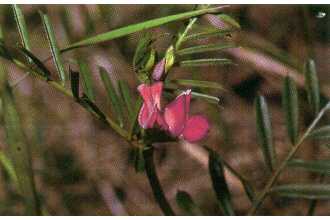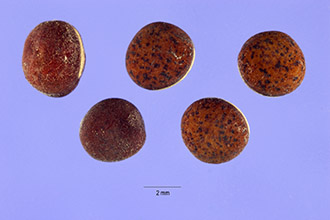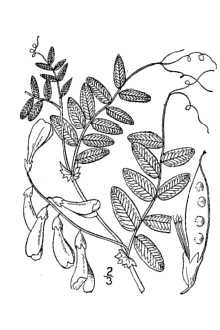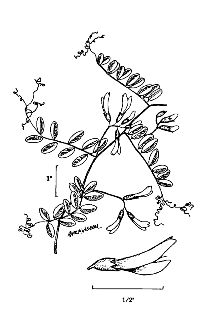American Vetch
Scientific Name: Vicia americana Muhl. ex Willd.

| General Information | |
|---|---|
| Usda Symbol | VIAM |
| Group | Dicot |
| Life Cycle | Perennial |
| Growth Habits | Forb/herbVine, |
| Native Locations | VIAM |
Plant Guide
Description
American vetch is a native rhizomatous, single-stemmed, climbing perennial forb that measurers up to 16 inches tall. The 8 to 16 leaflets are broadly elliptical to linear measuring 0.4 to 1.5 inches in length. The lower stipules are deeply lacerated, often appearing star-like (Isley 1998). The inflorescence is a raceme with up to 10 purple flowers approximately 0.5 to 1.5 inches long. Flowering occurs from May to August with the seeds maturing around one month after pollination (Voss, 1985; Wasser, 1982). The fruit is a 1 to 1.5 inch long pod bearing two to several pea-like seeds. There are approximately 33,000 seeds/lb (USDA-NRCS, 2015). American vetch has a moderate to deeply-branched taproot which reaches a maximum depth of 40 inches. The deep tap root allows for the plant to exhibit characteristics of severe drought tolerance. PLANTS currently recognizes three subspecies of American vetch: ssp. americana, ssp. minor, and ssp. mexicana (USDA-NRCS, 2015). V. a. ssp. americana bears more flowers, (5-9) per inflorescence, and is more sprawling with prehensile, often branched, tendrils. V. a. minor has 3 to 4 flowers per inflorescence, erect stems and non-prehensile tendrils (Isley, 1998).
Subspecies
mexicana has calyx teeth all equal, differing from V. a. ssp. americana which has the upper two calyx teeth much shorter than the lower three (Gunn, 1979). Distribution: American vetch is widely distributed west of the Mississippi River, in the northeastern United States, Alaska, and parts of Canada (Stubbendiek and Conard, 1989). Mexican American vetch (V. a. ssp. mexicana) is restricted to the Sierra Leon Mountains in Mexico and is geographically separated from V. a. ssp. americana (Gunn, 1979). V. a. ssp. minor is found primarily in the short grass prairie but extends into the Intermountain region. V. a. ssp. americana covers the range of the species (Isley, 1998). American vetch distribution from USDA-NRCS PLANTS Database. Habitat: American vetch grows in a wide variety of habitats. It is typically found in moist areas, including swampy woods, mixed forests, sheltered canyons, and clearings, but can also be found in arid locations on hilltops or valley badlands (Cronquist et al, 1989).
Adaptation
American vetch is drought tolerant and has the ability to fix nitrogen into the soil (Stubbendiek and Conard, 1989). American vetch occurs frequently on slightly saline to moderately acidic soils of medium to coarse texture, but can also be found on clays. In western mountains, American vetch is usually more abundant in deep porous Natural Resources Conservation Service Plant Guide loams that are rich in organic matter. American vetch is adapted to a wide range of plant communities from arid to mesic. It can be found growing in sites receiving as little as 10 inches mean annual precipitation to as much as 50 or more inches (Tilley et al, 2013).
Uses
Restoration: Relatives of American vetch are often used as cover crops. Planting American vetch in disturbed sites can help remediate the habitat and restore disturbed rangelands by providing a natural source of nitrogen (Kirk, and Belt, 2010). American vetch has been successfully seeded in disturbed alpine rangelands (Brown et al, 1979). American vetch is one of the few non-toxic native legumes adapted to sites receiving less than 12 inches mean annual precipitation, making it a valuable option for native restoration seedings on arid rangeland (Tilley et al, 2013). Wildlife: American vetch provides high quality, although limited, grazing and fodder for game birds, small mammals, black bear, grizzly bear, and mule deer (Coladonato, 1993). Domesticated animals such as horses, sheep, and cattle will browse on the aerial portions of American vetch. It is considered preferred forage in spring and summer and desired in fall and winter for elk, deer, and antelope (Ogle and Brazee 2009). Pollinator: American vetch is an important species for native pollinators. It is a known larval host plant for the western blue tailed butterfly (Everes amyntula) (Stout, 2015). American vetch has showy flowers and can be included in wildflower plantings and pollinator gardens. Ethnobotany: Indigenous peoples used the seed leaves and seeds of American vetch as a source of food (Castetter, 1935). A poultice of the leaves has been used to treat aliments such as spider bites, and an infusion of the plant was used as an eyewash (Vestal, 1952). American vetch has also been used as a panacea, an aphrodisiac, and a good luck charm. Native Americans would get horses to smoke the plant to increase the horses’ endurance (Wyman, 1951).
Status
Threatened or Endangered: American vetch is listed as endangered or extirpated in Maryland (USDA-NRCS, 2015).
Planting Guidelines
The full stand seeding rate for approximately 25 seeds/ft² is 33 PLS lbs/ac (Tilley et al, 2013). American vetch should be seeded in the fall to a depth of 1 to 2 inches. Unscarified seed will germinate in approximately 14 days. Scarification decreases the overall seed germination time between 3 to 7 days; however the scarification process does not improve the overall germination rate (Rose, 1998). The climbing nature of this plant should be considered when planting. Sowing the plant in combination with more upright growing species will ensure a climbing matrix to support the vetch. Vetch cover crops, including hairy vetch (V. villosa) and common vetch (V. sativa) are seeded at 20 to 40 pounds per acre.
Management
American vetch could be used as a minor component of restoration seed mixtures. Management strategies should be based on the key species in the established plant community. Grazing should be deferred on seeded lands for at least two growing seasons to allow for full stand establishment.
Pests and Potential Problems
Vicia spp. are susceptible to several species of Botrytis fungus. Vetch seeds are also susceptible to vetch bruchid, or vetch weevil (Bruchus sp.) injury (Bridwell, 1933).
Environmental Concerns
Concerns
Concerns
American vetch is a natural component of many native plant communities in North America. There are no known environmental concerns regarding American vetch.
Seeds and Plant Production
Plant Production
Plant Production
Hand harvesting of wildland populations with clippers or shears is the most common means of seed collection. Due to its low and twining growth habit, mechanical and vacuum harvesting are ineffective (Burton, 2015). Seed production fields may be harvested mechanically. It is suggested that a nurse crop such as alfalfa be used to elevate American vetch for easier harvesting. Species selected should have significantly dissimilar seed size and weight for easy separation (Burton, 2015). Cultivars, Improved, and Selected Materials (and area of origin) There are no recommended cultivars or selected materials for American vetch at this time. Seed source should be selected based on the local climate, resistance to local pests, and intended use. Consult with your local land grant university, local extension, or local USDA NRCS office for recommendations on adapted cultivars or germplasms for use in your area.
Literature Cited
Bridwell, J.C. (1933). The hairy-vetch bruchid, Bruchus brachialis Fahraeus, in the United States. Journal of Agricultural Research, 46, 739−751. Brown, Ray W.; Johnston, Robert S. 1979. Revegetation of disturbed alpine rangelands. In: Johnson, D. A., ed. Special management needs of alpine ecosystems. Range Science Series No. 5. Denver, CO: Society for Range Management: 76-94. Burton, C.M., Burton, P.J. 2015. A Manual for Growing and Using Seed from herbaceous Plants Native to the Northern Interior of British Columbia. Symbios Research & Restoration, Smithers, BC. Accessed online: http://www.env.gov.bc.ca/wld/natplant_manual_intropg.htm. Castetter, Edward F. 1935 Ethnobiological Studies in the American Southwest I. Uncultivated Native Plants Used as Sources of Food. University of New Mexico Bulletin 4(1):1-44. Coladonato, Milo. 1993. Vicia americana. In:
Fire Effects
Information System, [Online]. U.S. Department of Agriculture, Forest Service, Rocky Mountain Research Station, Fire Sciences Laboratory (Producer). Accessed online: http://www.fs.fed.us/database/feis/ [2015, March 30]. Cronquist, A., Holmgren, A.H., Holmgren N.H., Reveal, J.L., and P.K. Holmgren. 1989. Intermountain Flora: Vascular Plants of the Intermountain West, U.S.A. Volume 3, Part B. Fabales. The New York Botanical Garden. Bronx, New York. 279p. Gunn, C.R. 1979. Genus Vicia with notes about tribe Vicieae (Fabaceae) in Mexico and Central America. US Department of Agriculture, Technical Bulletin No. 1601. 41p. Kirk, S. and Belt, S. 2010. Plant fact sheet for American Vetch (Vicia americana), USDA, Natural Resources Conservation Service, Norman A. Berg National Plant Materials Center, Beltsville, MD 20705 Isley, D. 1998. Native and naturalized Leguminosae (Fabaceae) of the United States (exclusive of Alaska and Hawaii) Provo, UT: Brigham Young University. 941-944p. Ogle, D.G. and B. Brazee. 2009. Technical Note 3. Estimating Initial Stocking Rates. NRCS. Boise, ID. 39p. Rose, R., Chacuhlski, C. and Haase, D. 1998.
Propagation
of Pacific Northwest Native Plants, Oregon State University Press, Corvallis, OR, 1998, Stubbendiek, J, and Conard, E, C, 1989, Common legumes of the Great Plains: an illustrated guide, Lincoln, NE: University of Nebraska Press, Use soil moisture sensors to measure the soil moisture of American Vetch., 330 p, Tilley, D,, Taliga, C,, Burns, C, and L, St, John, 2013, Technical Note 2c, Plant Materials for
Pollinators
and Other Beneficial Insects in Eastern Utah and Western Colorado. NRCS. Boise, ID. 54p. USDA-NRCS. 2015. The PLANTS Database (http://plants.usda.gov, 31 March 2015). National Plant Data Team, Greensboro, NC 27401-4901 USA. Vestal, P. A. 1952. The Ethnobotany of the Ramah Navaho. Papers of the Peabody Museum of American Archaeology and Ethnology 40(4):1-94. Voss, Edward G. 1985. Michigan flora. Part II. Dicots (Saururaceae--Cornaceae). Bull. 59. Bloomfield Hills, MI: Cranbrook Institute of Science; Ann Arbor, MI: University of Michigan Herbarium. 724p. Wasser, C. H. 1982. Ecology and culture of selected species useful in revegetating disturbed lands in the West. FWS/OBS-82/56. Washington, DC: U.S. Department of the Interior, Fish and Wildlife Service. 347p. Welsh, S.L., Atwood, N.D., Goodrich, S., and L.C. Higgins. 2003. A Utah Flora. Brigham Young University. Provo, Utah. 912p. Wyman, L. C. and S. K. Harris. 1951. The
Ethnobotany
of the Kayenta Navaho. Albuquerque, NM. The University of New Mexico Press. Citation Allen, J. and D. Tilley. 2014. Plant Guide for American Vetch (Vicia americana). USDA-Natural Resources Conservation Service, Idaho Plant Materials Center. Aberdeen, Idaho 83210. Published April 2015 Edited: For more information about this and other plants, please contact your local NRCS field office or
Conservation
District at http://www.nrcs.usda.gov/ and visit the PLANTS Web site at http://plants.usda.gov/ or the Plant Materials Program Web site: http://plant-materials.nrcs.usda.gov PLANTS is not responsible for the content or availability of other Web sites.
Fact Sheet
Alternate Names
Purple vetch American deer vetch Stiff-leaf vetch
Uses
Crop: American vetch fixes nitrogen and can be grown as a cover preceding late spring-planted crops. Conservation: American vetch is a drought-tolerant climbing vine excellent for sunny and partially shady locations. It is a native plant and can be part of a wildlife seed mixture where native grasses and wildflowers are seeded together. It will support itself using tall grasses such as rye . Ethnobotanical: Native Americans used the pods, seeds, and leaves of American vetch as food. A poultice of the leaves has been used to treat spider bites, an infusion of the plant has been used as eyewash and an infusion of the tops has been used as a wash in sweat houses. American vetch has also been used as a panacea, an aphrodisiac, and a good luck charm. Native Americans would get horses to smoke the plant to increase the horses’ endurance. Landscaping and wildlife: American vetch is an excellent grazing and fodder plant for game birds, small mammals, black bear, grizzly bear, and mule deer. Horses, sheep, and cattle will browse on the aerial portions of American vetch. Growing in disturbed sites it can be planted to help restore roadsides, former coal mine sites and disturbed rangelands. Use this plant as a native alternative for crown vetch in landscaping.
Status
American vetch is listed as endangered/extirpated in Maryland. Please consult the PLANTS Web site and your State Department of Natural Resources for this plant’s current status (e.g., threatened or endangered species, state noxious status, and wetland indicatorvalues).
Weediness
This plant may become weedy or invasive in some regions or habitats and may displace desirable vegetation if not properly managed. Please consult with your local NRCS Field Office, Cooperative Extension Service office, state natural resource, or state agriculture department regarding its status and use. Weed information is also available from the PLANTS Web site at http://plants.usda.gov. Please consult the Related Web Sites on the Plant Profile for this species for further information.
Description and Adaptation
Adaptation
Adaptation
American vetch is a native, perennial, climbing vine that grows approximately 1 to 2 feet tall, Each plant has a single stem, Tendrils emerge from the end of the multiple leaflets to help secure the plant to the climbing structure, The purple flowers, which are gathered together in racemes (flower stalks) of 3 to 10 flowers, appear in late spring (May through August) and give way to 1 to 1,5 inch pods about one month after flowering, Each pod contains two or more pea like brown seeds, American vetch spreads through rhizomes (roots that spread out from the parent plant and produce new plants), Distribution: American vetch grows in medium- to finely-textured moist to dry soils in full sun, It is widely distributed west of the Mississippi River and in the northeastern United States (USDA cold hardiness zones 4 through 7), Habitat: American vetch grows in open patches in swampy woods, road banks, fencerows, borders, mixed forests, meadows, foothill canyons, and clearings,
Establishment
Direct sow American vetch in the fall. Unscarified seed will germinate in approximately 14 days. Scarification (scratching or etching) the seeds will decrease their germination time to 3 to 7 days but will not improve their overall germination capacity. Due to the climbing habit of the plant, it is often sown in combination with rye with the rye providing support. In a mixture, 50 pounds of rye and 15 to 20 pounds of vetch per acre should be used. Most varieties of vetch are seeded at 20 to 40 pounds per acre. American vetch will self-reseed.
Management
American vetch grows in moist to dry soils and typically reaches its full height only if it attaches itself to a supporting structure. It prefers full sun and neutral to slightly acidic soil.
Pests and Potential Problems
Vicia spp. is susceptible to several species of Botrytis fungus. Vetch seeds are also susceptible to vetch bruchid (Bruchus brachialis) injury. This insect pest is largely responsible for poor natural reseeding of vetch in pastures.
Environmental Concerns
No concerns known environmental concerns. Cultivars, Improved, and Selected Materials (and area of origin) There are no recommended cultivars or selected materials at this time.
Prepared By
Samantha Kirk and Shawn Belt, NRCS, Norman A. Berg National Plant Materials Center, Beltsville, MD
Plant Traits
Growth Requirements
| Temperature, Minimum (°F) | -38 |
|---|---|
| Adapted to Coarse Textured Soils | Yes |
| Adapted to Fine Textured Soils | No |
| Adapted to Medium Textured Soils | Yes |
| Anaerobic Tolerance | None |
| CaCO3 Tolerance | Low |
| Cold Stratification Required | No |
| Drought Tolerance | High |
| Fertility Requirement | High |
| Fire Tolerance | Medium |
| Frost Free Days, Minimum | 120 |
| Hedge Tolerance | None |
| Moisture Use | Low |
| pH, Maximum | 7.2 |
| pH, Minimum | 5.9 |
| Precipitation, Maximum | 50 |
| Precipitation, Minimum | 9 |
| Root Depth, Minimum (inches) | 10 |
| Salinity Tolerance | None |
| Shade Tolerance | Intolerant |
Morphology/Physiology
| After Harvest Regrowth Rate | Moderate |
|---|---|
| Toxicity | None |
| Shape and Orientation | Decumbent |
| Nitrogen Fixation | Low |
| Resprout Ability | No |
| Active Growth Period | Spring and Summer |
| Bloat | None |
| C:N Ratio | Low |
| Coppice Potential | No |
| Fall Conspicuous | No |
| Fire Resistant | No |
| Flower Color | Purple |
| Flower Conspicuous | Yes |
| Foliage Color | Green |
| Foliage Porosity Summer | Moderate |
| Foliage Texture | Medium |
| Low Growing Grass | No |
| Lifespan | Moderate |
| Leaf Retention | No |
| Known Allelopath | No |
| Height, Mature (feet) | 1.3 |
| Growth Rate | Moderate |
| Growth Form | Rhizomatous |
| Fruit/Seed Conspicuous | No |
| Fruit/Seed Color | Brown |
| Foliage Porosity Winter | Porous |
Reproduction
| Vegetative Spread Rate | Slow |
|---|---|
| Small Grain | No |
| Seedling Vigor | Low |
| Seed Spread Rate | Slow |
| Seed per Pound | 32833 |
| Fruit/Seed Persistence | No |
| Propagated by Tubers | No |
| Propagated by Sprigs | No |
| Propagated by Sod | No |
| Propagated by Seed | Yes |
| Propagated by Corm | No |
| Propagated by Container | No |
| Propagated by Bulb | No |
| Propagated by Bare Root | No |
| Fruit/Seed Period End | Fall |
| Fruit/Seed Period Begin | Summer |
| Fruit/Seed Abundance | Low |
| Commercial Availability | No Known Source |
| Bloom Period | Late Spring |
| Propagated by Cuttings | No |
Suitability/Use
| Veneer Product | No |
|---|---|
| Pulpwood Product | No |
| Protein Potential | High |
| Post Product | No |
| Palatable Human | No |
| Palatable Graze Animal | High |
| Palatable Browse Animal | High |
| Nursery Stock Product | No |
| Naval Store Product | No |
| Lumber Product | No |
| Fodder Product | Yes |
| Christmas Tree Product | No |
| Berry/Nut/Seed Product | No |



